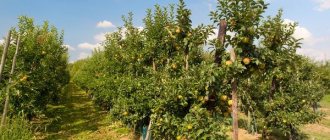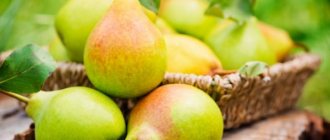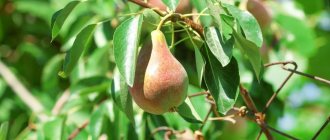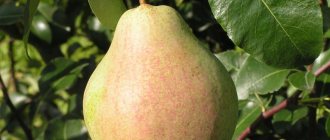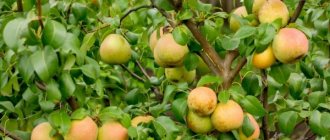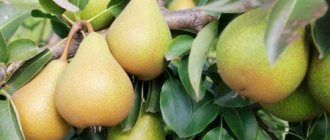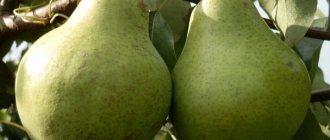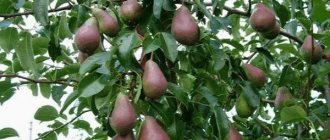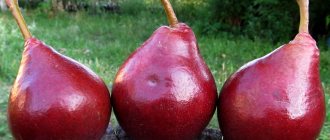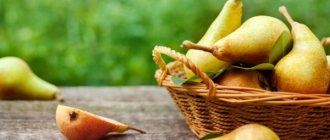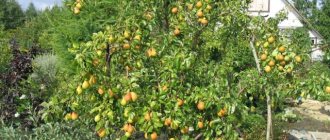Gardening » Pear
0
1664
Article rating
Kira Stoletova
The Kudesnitsa pear was bred in Belarus as a hybrid that combined the best qualities of three varieties - Sapezhanka, Druzhba and Lagodnaya. High yield and excellent taste have made this variety popular among many gardeners.
Characteristics of pear variety Kudesnitsa
Description of the variety
Pear is a summer ripening variety. The variety is widespread in Europe and has been included in the State Register of Belarus since 2011.
Characteristics of wood
The trees are medium-sized and reach 4-5 meters in height when mature. The crown is wide, moderately dense, and has the shape of a pyramid. The branches are covered with dark brown bark. The leaves are small, round, bright green. The surface of the leaf plate is smooth, with a characteristic shine.
Description of fruits
Pears Magician.
The fruits are large and reach a weight of 150-200 grams. The shape of pears is truncated-conical. The main color of the ripe fruit is light green. There is a slight pink blush on the surface. Pears have a pleasant, sweet, semi-oily taste and a distinct aroma.
Fruit maturity occurs in the second ten days of August. The shelf life of the harvested crop is 2-3 weeks.
Pear Magician
Main characteristics
Fruit ripening period:
detailed information
Origin of the variety
The pear variety Kudesnitsa, a summer variety, was bred in the Republic of Belarus in 2011. In the State Register of Varieties and Tree and Shrub Species it is listed under number 2008147. It is zoned in the Grodno region. Kudesnitsa is a hybrid of three varieties that combines the best qualities of each of them: Lagodnaya, Sapezhanka and Druzhba.
Application
The fruits can be consumed both fresh and processed. From the Magician you can make delicious preserves, marmalade, compote, jam, candied fruits, wine and even honey.
Climatic conditions
Kudesnitsa is an undemanding pear variety. Of course, if possible, it is better to plant it in fertile, loose and well-drained soil, but the tree can develop in less favorable conditions. The only thing you really need to take care of is that the soil is not too moist and that there is no stagnation of water - the pear cannot tolerate such conditions. This variety also loves sunlight very much, but does not tolerate extreme heat and drought.
Landing
It is best to plant the Magician on the western or southwestern part of the site.
Caring for the Magician pear is quite standard: in spring and summer, the tree needs to be regularly watered in the circle around the trunk (3 buckets per square meter), periodically the soil needs to be loosened. It is also useful to fertilize the soil: with compost, wood ash and slaked lime. Among the advantages of the Kudesnitsa pear are early fruiting and good taste. The main disadvantage is the short consumption period.
Diseases/pests
The magician is relatively resistant to diseases and pests. It makes sense to regularly spray the tree against them.
Fruit
Fruiting in the Magician is concentrated on spears, simple and complex ringlets. The truncated conical fruits growing on the branches are quite large: their weight can range from 160 to 180 grams. Sometimes pears can be larger - up to 200 grams! The color of the fruit is green with a slight reddish coating on the part of the fruit facing the sun. The skin is medium thick, smooth and shiny, dry. The pulp tastes fine-grained and very sweet, juicy and semi-oily. Its light is light green. Pears are very fragrant. According to the tasting scale, the taste qualities of the Magician are rated at 4.6 points out of the maximum possible 5 - a fairly high result. This variety is high-yielding. When grown in industrial conditions, up to 20 tons of fruit can be collected from one hectare. The period of harvest and consumer ripeness occurs in mid-August. But the main disadvantage of Magician is its short shelf life. Even in the refrigerator, pears cannot last more than 2-3 weeks.
Reviews
Lidia Ivanovna
Pushchino
The tree began to bear fruit very quickly and I collected the first harvest already in the 4th year. The first years there were not very many fruits, but after a couple of seasons the harvest was quite decent.
Sergey
Kursk
The pear tree rarely gets sick, but after every prolonged rain I spray the tree for prevention. In addition, I am pleased that this variety bears fruit well even without pollinators.
Lyudmila
Tula region
The Magician has very tasty fruits. Our whole family loves to eat them fresh, but unfortunately pears don’t last long.
Wood appearance
Magician pear
According to its external characteristics, the tree of the kudesnitsa variety can be assessed as vigorous. The pear has a crown of medium density and a wide pyramidal shape. This variety is considered early-bearing, since the tree reaches fruiting age already 3-4 years after planting. The pear also shows high winter hardiness for the Republic of Belarus, but its roots still need to be covered with snow during severe frosts.
Landing
Pear is unpretentious and adapts well to different conditions. In the articles below, you can find detailed instructions and tips for planting Magician seedlings.
How to plant a pear tree correctly
At what distance to plant pears?
How to choose pear seedlings
How to replant a pear
Care
A tree of the Kudesnitsa variety is capable of fully growing and developing even with minimal care. More details about the features of growing pears of this variety can be found in the selection of articles listed below.
How to care for a pear Pruning a pear Pruning a columnar pear Treating a pear from diseases and pests Feeding a pear How to water a pear
History of selection and region of breeding of the variety
Miracle is a very young variety. It was bred in the Tambov region on the basis of the State Scientific Institution “All-Russian Research Institute of Genetics and Selection of Fruit Plants named after. I.V. Michurin", which, as is known, is the oldest selection and genetic fruit school in the Russian Federation.
The authors of the variety - S. P. Yakovlev, A. P. Gribanovsky, N. I. Savelyev, E. N. Dzhigadlo and V. V. Chivilev - set themselves the goal of obtaining a high-yielding and frost-resistant pear, ideal for growing in the middle zone European part of Russia. For this purpose, scientists crossed the Daughter of the Dawn and the Talgar beauty.
Did you know? There are legends about the amazing abilities of I.V. Michurin. They say that a great plant breeder could bring a dying plant back to life simply by talking to it; Guard dogs never barked at the scientist, and birds easily sat on his palms.
The hybrid obtained as a result of such an experiment acquired fertility from the first of its “parents,” as well as the aroma and fine-grained structure of the pear pulp; from the second, in addition to winter hardiness, the characteristic elongated shape and amber color of the fruit.
Chudesnitsa was included in the State Plant Register of the Russian Federation in 2004 (the application was submitted three years earlier) and recommended for cultivation in the Central Black Earth region as a winter pear variety.
In addition to Russia, where this variety is distributed primarily in the Moscow, Leningrad, Voronezh and Yaroslavl regions, Chudesnitsa has also taken root well in neighboring countries, in particular in Moldova, Belarus, Ukraine and Kazakhstan.
Diseases and pests
The Kudesnitsa variety has good immunity to various diseases, but often becomes a victim of harmful insects. By clicking on the links below, you can find many useful recommendations for carrying out protective and preventive measures.
Dangerous Pear Pests
Pears often suffer from pests, they affect the leaves, bark and fruits.
In this article, we have selected 11 of the most harmful insects that harm pear trees, and also ways to destroy them.
Diseases of pear trees
To get what they cherish, gardeners have to work hard, and the reason for this is pear diseases.
Read about 19 common pear diseases and how to combat them.
Characteristics of the Chudesnitsa pear variety
Pear Chudesnitsa is a new winter pear variety obtained by Russian scientists as a result of crossing.
Characteristics of the Chudesnitsa pear variety
Characteristics of the variety
According to the description, the Chudesnitsa pear variety is characterized by:
- good winter hardiness (tolerates temperatures of -38°C without freezing of the bark or damage to cambium tissue);
- high productivity;
- average fruiting (the tree bears fruit 5-6 years after planting);
- duration of consumption (fruits are stored for up to 4 months, provided that the room is cool);
- harvesting in the second and third decades of September; durability (gives harvests up to 50-70 years);
- not picky about soil;
- ripening of fruits in a plucked state to gain flavor and sweetness.
Description of the tree
According to the description, pears of the Kudesnitsa variety are vigorous. Their crown has an oval shape and an average level of density. The main disadvantage is the reduction of fruits due to thickening of the crown. The bush has a mixed type of fruiting. The shoots of this fruit tree are relatively thin and greenish-brown, with small buds and relatively small green leaves with a round, upward-curving shape.
Description of the fruit
The fruits of this fruit tree are characterized by closed seed chambers. Small saucer, straight, medium-sized stalk. The seeds are also small and narrow. During the ripening period, the fruit has a rich yellow color, sometimes with a blurred blush.
The pulp is white and tender, most often oily. The fruit tastes sweet, with a slight sour taste, and has a faint aroma. This fruit is actively used to prepare certain types of wines and various sweets. It is also popular in folk medicine. It is sometimes used in the production of treatments for a number of viral diseases.
The Miracle Pear, as described by gardeners, does not require special care. All she needs is:
- access to direct sunlight (the best option for planting is the south or west side);
- preferably drained and fertile soils;
- moderate soil moisture, because excessive moisture and stagnation of moisture harm the fruit tree;
- mandatory pruning (any method will do: shortening, transferring to branches, thinning);
- optimal irrigation system - sprinkling with a sprayer that imitates natural rain;
- loosening to provide the soil with oxygen after watering;
- applying fertilizers in autumn and spring, starting from the second year;
- good insulation of the roots in the cold season, while the trunk is wrapped with film or paper.
The tree is easy to care for
If the tree grows in soil conditions with high levels of sand or clay, the soil must be prepared in advance. The best option is to change the land storage manually. This requires:
- purchase 2-3 bags of ready-made soil mixture for fruit trees;
- dig a small pit in the area planned for planting the crop;
- mix the soil taken from the pit with the prepared soil mixture in the proportion of 3 m of soil mixture per 1 m of local soil.
Part of the prepared mixture is placed at the bottom of the hole, and part is left to cover the roots of the seedling.
Diseases
It does not suffer from scab, which is widespread in temperate climates, which gives it a significant advantage in the market over other fruits. The tree is not affected by entomosporia, which negatively affects the formation of buds and gives the leaves a brown color.
The main danger is pests:
- brown fruit mite;
- blue-headed armyworm;
- goose;
- mole.
Brown fruit mite
Brown fruit mites overwinter in cracks in the bark, and in the spring they molt and lay eggs on the leaves. In less than a month, the larvae become adult ticks. The cycle is repeated many times.
To combat brown fruit mites in the spring, the tree is sprayed with acaricides. The drug used is changed so that ticks do not develop immunity to it. If the lesions are too severe, resort to the use of nitrafen or oleocuprite.
Blue-headed armyworm
It is a large butterfly with brown wings that lays eggs in the crown of trees for the winter. To combat it, the branches are regularly inspected and the caterpillars are shaken off, followed by the destruction of the pest.
If the invasion of the blue-headed armyworm is widespread, the tree is treated with insecticides. Do this before flowering.
